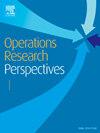家庭健康照护路线与排程问题简评
IF 3.7
4区 管理学
Q2 OPERATIONS RESEARCH & MANAGEMENT SCIENCE
引用次数: 0
摘要
家庭医疗保健路线和调度问题(HHCRSP)在优化家庭医疗保健服务的交付方面发挥着至关重要的作用,它通过有效地将护理人员分配到患者所在地,同时遵守后勤、操作和监管限制。这篇简明的综述提供了对HHCRSP的分析,讨论了其主要目标、制约因素和解决方法。该研究考察了各种优化方法,包括精确算法、启发式和元启发式技术。此外,本文还探讨了HHCRSP对医疗服务效率的影响,强调了其在降低运营成本、提高服务质量和确保护理连续性方面的作用。本文还讨论了影响HHCRSP的监管要求,解决了法律和组织要求的遵从性、质量保证框架、经济约束和患者优先级要求。与HHCRSP相关的挑战,包括后勤复杂性、工作负载平衡和技术障碍,也进行了审查。为了使HHCRSP与监管框架保持一致,本综述讨论了各种策略,如自适应调度、先进的算法解决方案以及环境和社会可持续性考虑的整合。此外,新兴的技术进步,包括人工智能(AI)、物联网(IoT)和智能交通系统的使用,对其提高HHCRSP效率的潜力进行了评估。文章最后总结了主要发现,讨论了HHCRSP对医疗服务提供者的实际意义,并概述了未来的研究方向。解决现有的差距,如人工智能的可解释性、用于安全调度的区块链集成以及可持续的医疗保健物流,仍然是进一步探索的关键途径。随着对家庭医疗保健服务需求的增长,创新的HHCRSP解决方案对于确保高质量、低成本和以患者为中心的护理至关重要。本文章由计算机程序翻译,如有差异,请以英文原文为准。
A Concise Review of Home Health Care Routing and Scheduling Problem
The Home Health Care Routing and Scheduling Problem (HHCRSP) plays a crucial role in optimizing the delivery of home-based healthcare services by efficiently allocating caregivers to patient locations while adhering to logistical, operational, and regulatory constraints. This concise review provides an analysis of HHCRSP, discussing its key objectives, constraints, and solution methodologies. The study examines various optimization approaches, including exact algorithms, heuristics, and metaheuristic techniques. Furthermore, the impact of HHCRSP on healthcare delivery efficiency is explored, highlighting its role in reducing operational costs, improving service quality, and ensuring continuity of care. The article also discusses the regulatory requirements affecting HHCRSP, addressing compliance with legal and organizational requirements, quality assurance frameworks, economic constraints, and patient prioritization mandates. The challenges associated with HHCRSP, including logistical complexities, workload balancing, and technological barriers, are also reviewed. To align HHCRSP with regulatory frameworks, this review discusses various strategies such as adaptive scheduling, advanced algorithmic solutions, and the integration of environmental and social sustainability considerations. Additionally, emerging technological advancements, including the use of Artificial Intelligence (AI), Internet of Things (IoT), and intelligent transport systems, are evaluated for their potential to enhance HHCRSP efficiency. The article concludes by summarizing key findings, discussing the practical implications of HHCRSP for healthcare providers, and outlining future research directions. Addressing existing gaps, such as AI explainability, blockchain integration for secure scheduling, and sustainable healthcare logistics, remains a critical avenue for further exploration. As the demand for home healthcare services grows, innovative HHCRSP solutions will be essential to ensuring high-quality, cost-effective, and patient-centered care.
求助全文
通过发布文献求助,成功后即可免费获取论文全文。
去求助
来源期刊

Operations Research Perspectives
Mathematics-Statistics and Probability
CiteScore
6.40
自引率
0.00%
发文量
36
审稿时长
27 days
 求助内容:
求助内容: 应助结果提醒方式:
应助结果提醒方式:


